Étiquette : Schubert
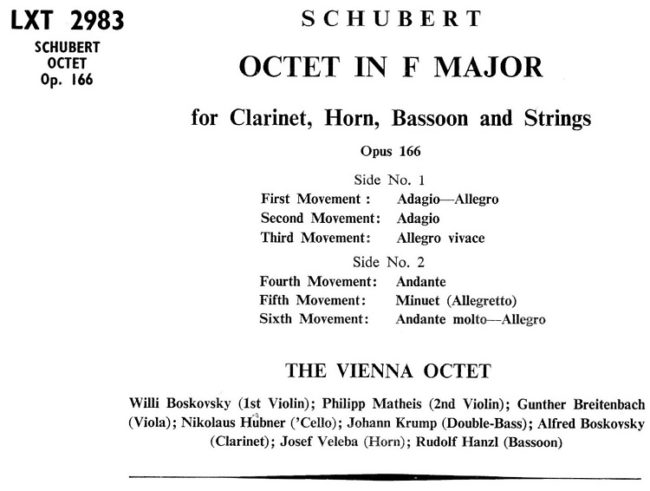
Willi Boskovsky Violine I, Philipp Matheis, Violine II; Günther Breitenbach, Bratsche;
Nikolaus Hübner, Cello; Johann Krump Kontrabass;
Alfred Boskovsky, Klarinette ; Josef Veleba, Horn ; Rudolf Hanzl, Fagott
Schubert Oktett Op.166 D.803
Enregistrement /Recording: Wien Musikvereinsaal – 26 & 27 April 1954
Pr: Victor Olof; Eng: Cyril Windebank
Source 33t/LP: Decca LXT 2983
‘Wenn man Schubert gehört hat, kann einem nichts Gescheites mehr einfallen’
(Richard Strauss)
L’Octuor de Vienne (Wiener Oktett) a joué cet Octuor en public un grand nombre de fois et il l’a enregistré à plusieurs reprises.
Si on s’en tient à la formation d’origine dont Willi Boskovsky était le premier violon, on a:
1- Genève (Studio Radio) – Juillet 1948
2- Wien Musikvereinsaal – 26-27 avril 1954
3- Wien Sofiensaal – 20-29 mars 1958
L’enregistrement 78 tours de 1948 n’a pas été réédité, de même que l’enregistrement mono de 1954, au bénéfice de l’enregistrement de 1958 qui a l’avantage de la stéréo.
Au cours de l’année 1948, les musiciens du Wiener Oktett et du WPO ont eu l’occasion de se produire lors de deux concerts à Montreux en présence de deux auditeurs prestigieux, Richard Strauss et son épouse Pauline de Ahna, qui y résidaient alors.
Le premier a été donné à la Kursaal le 30 avril 1948 par le Wiener Oktett avec au programme le Septuor de Beethoven et l’Octuor de Schubert (annonce dans le ‘Journal de Montreux’ du 29 avril 1948):
 Richard Strauss était assis au premier rang d’orchestre et il a tout particulièrement apprécié l’exécution de l’Octuor de Schubert. Quand il s’est rendu dans la loge des musiciens à la fin du concert, ceux-ci lui ont demandé s’il ne pouvait pas composer une œuvre pour son ensemble. Mais Richard Strauss leur fit signe que non et leur dit alors la phrase en exergue: ‘Quand on a entendu Schubert, rien de bien valable ne peut plus venir à l’esprit’.
Richard Strauss était assis au premier rang d’orchestre et il a tout particulièrement apprécié l’exécution de l’Octuor de Schubert. Quand il s’est rendu dans la loge des musiciens à la fin du concert, ceux-ci lui ont demandé s’il ne pouvait pas composer une œuvre pour son ensemble. Mais Richard Strauss leur fit signe que non et leur dit alors la phrase en exergue: ‘Quand on a entendu Schubert, rien de bien valable ne peut plus venir à l’esprit’.
Un peu plus tard, le 5 juin, les Wiener Philharmoniker (WPO) ont, au cours d’une courte tournée en Suisse sous la direction de Furtwängler, donné un concert à Montreux, dans la Salle du Pavillon. Le programme publié à l’avance comprenait: Mozart Sérénade ‘Gran Partita’ K.361; Schubert Symphonie n° 8 ‘Inachevée’ et Beethoven Symphonie n° 3. En raison de la présence de Richard Strauss dans la salle, son ‘Don Juan’ a été joué à la place de la Symphonie de Schubert.

Dans le Journal de Montreux du 7 juin, on pouvait lire: ‘Nous avons parfois dans un concert, l’impression que l’interprétation d’un certain morceau représente l’interprétation type, idéale, de ce morceau, celle qui le réalise avec adéquation. Eh bien, Furtwängler nous a semblé donner une telle interprétation de ‘Don Juan’. Peut-être que Richard Strauss partage notre avis, lui qui assistait au concert, et que la foule enthousiaste a applaudi en même temps que Furtwängler.’
Et en effet, à la fin du concert, le compositeur alla dans sa loge pour en remercier Furtwängler*, très touché. Frau Strauss dit alors à son mari: ‘Aussi beau que ça, je ne l’ai jamais entendu de ta part’ (‘So schön habe ich das von dir noch nie gehört’). Et Strauss de répliquer: ‘Bon, mais ce n’est tout de même pas lui qui l’a composé!’ (‘Na ja, dafür hat er‘s net komponiert!’).
Fin novembre et début décembre 1947, Furtwängler et treize instrumentistes à vents du WPO ont enregistré la Gran Partita’ de Mozart. En juillet 1948, le Wiener Oktett a mis en disques l’Octuor de Schubert. On peut imaginer que ces deux enregistrements restituent des interprétations proches de ce que Richard Strauss a pu écouter en concert à Montreux. Pour l‘œuvre de Schubert, en attendant une réédition souhaitable de l’enregistrement de 1948, on peut apprécier la très belle version de 1954, fort bien captée.
* Ce ne fut pas leur seule rencontre. Le couple Strauss a résidé au Montreux Palace de septembre 1947 à mai 1949, et Furtwängler qui habitait à Clarens est parfois venu leur rendre visite en voisin.
______________________________
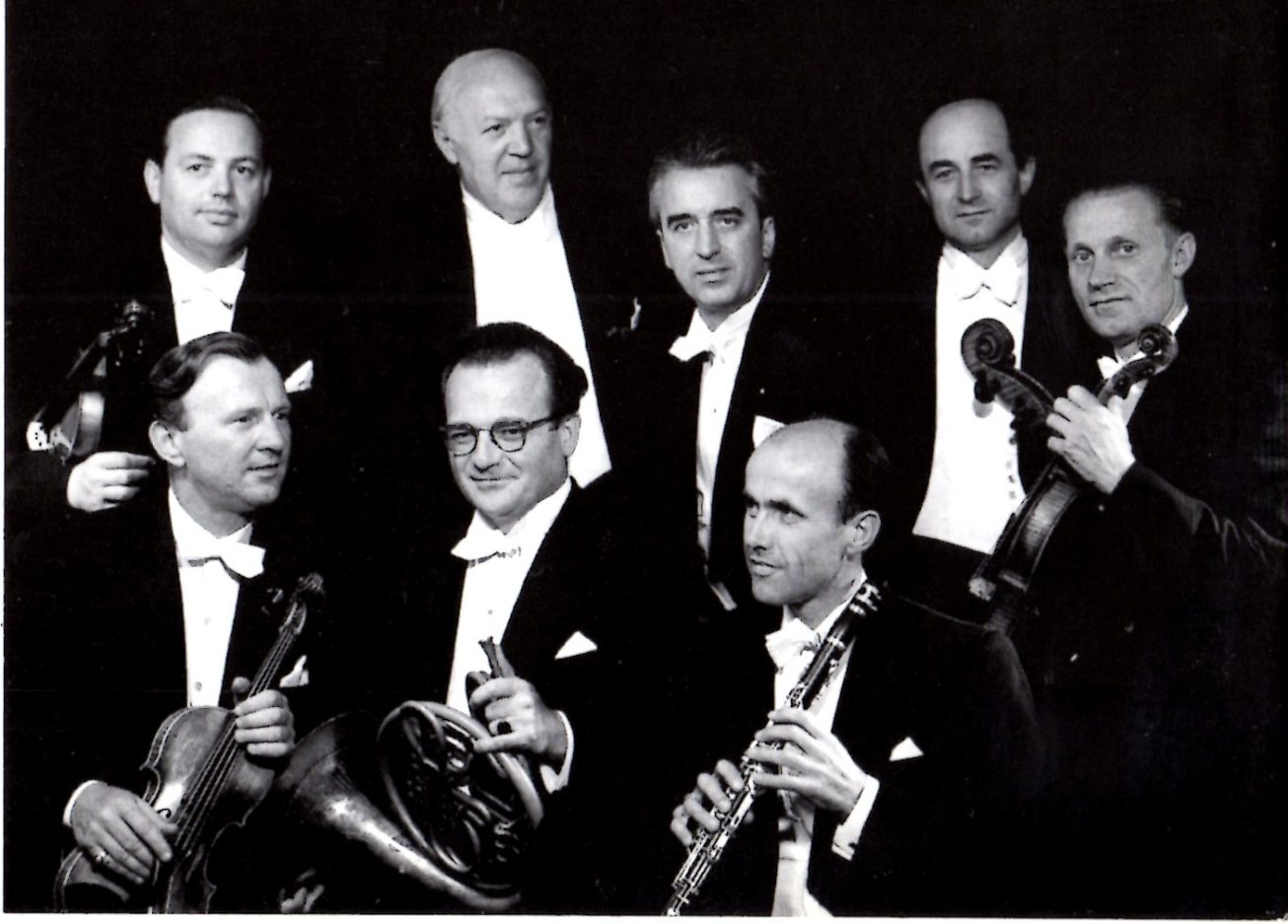
Wiener Oktett
Premier Rang /First Row: Willi Boskovsky; Josef Veleba; Alfred Boskovsky
Deuxième Rang/Second Row: Philipp Matheis; Johann Krump; Rudolf Hanzl; Nikolaus Hübner; Günther Breitenbach
______________________________
The Vienna Octet (Wiener Oktett) performed Schubert’s Octet many times and recorded it several times.
With the original members, with Willi Boskovsky as first violin, we have:
1- Geneva (Studio Radio) – July 1948
2- Wien Musikvereinsaal – 26-27 April 1954
3- Wien Sofiensaal – 20-29 March 1958
The 1948 78rpm recording has not ben re-issued, nor the 1954 mono recording, unlike the 1958 version that benefits from stereo.
In 1948, the musicians from the Wiener Oktett and from the WPO had the opportunity of playing during two concerts in Montreux before two celebrated spectators, Richard Strauss and his wife Pauline de Ahna, who were then living there.
The first was given at the Kursaal on 30 April 1948 by the Wiener Oktett and the program was Beethoven’s Septet and Schubert’s Octet (announcement in the ‘ Journal de Montreux’ of 29 April 1948):
Richard Strauss sat in the first row and he was particularly delighted by the performance of Schubert’s Octet. As he went to the musicians’ dressing-room at the end of the concert, they asked him whether he could compose a work for their ensemble. But Richard Strauss shook his head and then said the above-cited words: ‘When one has heard Schubert, nothing clever may come to the mind any more’.
Somewhat later, on 5 June, the Wiener Philharmoniker (WPO), during a short Swiss tour conducted by Furtwängler, gave a concert in Montreux, in the ‘Salle du Pavillon’. The program that was published in advance was comprised of: Mozart Serenade ‘Gran Partita’ K.361; Schubert’s Symphony n° 8 ‘Unfinished’ and Beethoven’s Symphony n° 3. Because Richard Strauss attended the concert, his ‘Don Juan’ was performed instead of Schubert’s Symphony.

In the 7 June edition of the ‘Journal de Montreux’, one read: ‘ In a concert, we have sometimes the impression that the interpretation of a given piece represents the reference, the ideal interpretation of that piece, that is the adequate rendering. Well, Furtwängler seemed to us to have given such an interpretation of ‘Don Juan’. Perhaps Richard Strauss shares our view, he who attended the concert, and who was applauded by the enthusiastic crowd, at the same time as Furtwängler.’
And indeed, at the end of the concert, the composer went to his dressing-room to thank for it Furtwängler*, very moved. Frau Strauss then said to her husband: ‘As beautiful as this, I have never heard from you’ (‘So schön habe ich das von dir noch nie gehört’). Then came Strauss’ reply: ‘Well, however, he is not the one who composed it!’ (‘Na ja, dafür hat er‘s net komponiert!’).
At the end of November and the beginning of December 1947, Furtwängler and thirteen wind players from the WPO recorded the ‘Gran Partita’ by Mozart. In July 1948, the Wiener Oktett committed to disc Schubert’s Octet. One may imagine that these two recordings reproduce interpretations close to what Richard Strauss heard live in Montreux. For the Schubert work, while awaiting a desirable re-issue of the 1948 recording, one may appreciate the very good 1954 version, very well recorded.
* This was not the only time that they met. Strauss and his wife lived at the ‘Montreux Palace’ from September 1947 to May 1949, and Furtwängler who lived in Clarens came sometimes as a neighbour to pay them a visit.
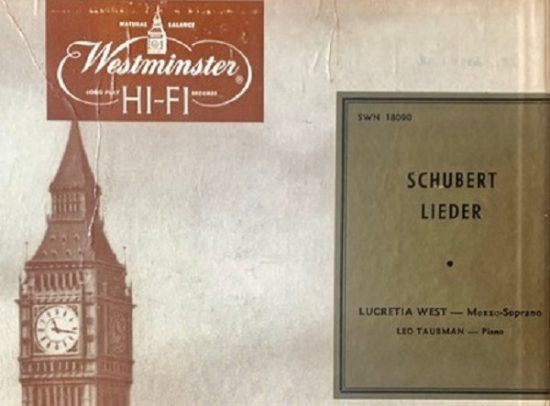
Lucretia West, mezzo-soprano Leo Taubman, piano
Schubert Lieder
An Die Musik D547 – Dem Unendlichen D291 – Wanderers Nachtlied D768
Seligkeit D433 – Die Liebe hat gelogen D751 – Rastlose Liebe D138
Der Tod und das Mädchen D531 – Wiegenlied D498 – Schlummerlied D527
Fischerweise D881 – Im Abendrot D799 – Nacht und Träume D827
Geistertanz D116 – Widerschein* D639 – Wehmut D772
Enregistrement / Recording: 1955
Source: 33t. / LP Westminster WN 18090
La cantatrice américaine Lucretia West (1922-2022) a fait l’essentiel de sa carrière en Suisse et en Allemagne. Une bourse de la ‘John Hay Whitney Fondation’ lui a permis de poursuivre ses études en Belgique et en Suisse. Elle a fait brièvement partie de la ‘New York City Opera Company’ avant de retourner en Europe en 1957 pour le reste de sa carrière. Elle a enseigné en Allemagne jusqu’en 2008 avant de retourner aux Etats-Unis.
Sa discographie officielle se limite à ses enregistrements pour la firme Wesminster notamment avec Hermann Scherchen (Mahler, Mozart) et avec accompagnement de piano, et à l’ ‘Alt-Rhapsodie’ de Brahms avec Knappertsbusch (Decca). Il existe aussi un disque de ‘Spirituals’ pour le Club Français de Disque. Quelques enregistrements radiophoniques réalisées en Europe (Schuricht, Mitropoulos) ont été publiés, mais il est possible qu’il en existe bien d’autres, notamment dans le domaine du Lied.
Bien que considérée comme une mezzo-soprano, elle avait une tessiture proche de celle d’un contralto. Le 9 juin 1958, elle a chanté à Hambourg le ‘Das Lied von der Erde’ de Mahler avec le NDR-Sinfoniker dirigé par Alfred Wallenstein (et le ténor Richard Holm), concert retransmis en direct à la radio. Un critique avait apprécié son interprétation et parlé à son sujet de ‘Bratschentimbre’ (timbre d’alto, comme l’instrument à cordes).
Le programme de ce disque entièrement consacré par une voix aussi grave à des Lieder de Schubert est en soi une rareté. Elle est ci remarquablement accompagnée par Leo Taubman (1907-1966).
* Schubert a écrit plusieurs versions de ce Lied, correspondant à des versions successives du poème. Ici, il s’agit de la 2ème version et de sa première révision. Le texte commence par «Tom lehnt harrend auf der Brücke…’
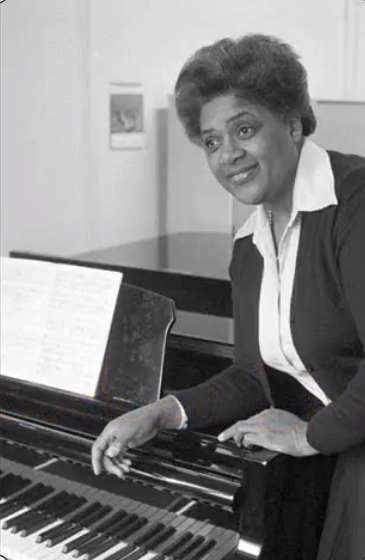
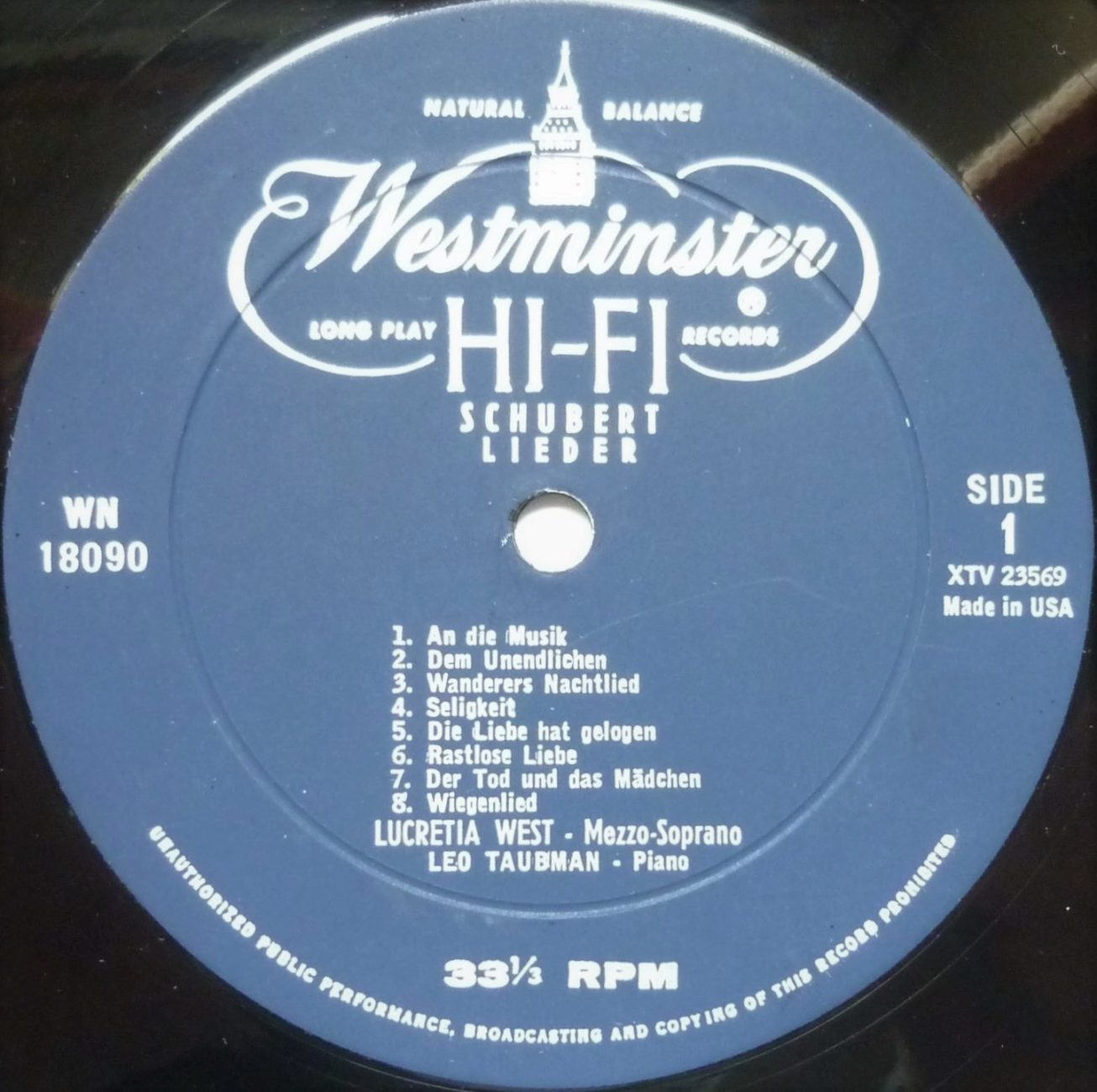
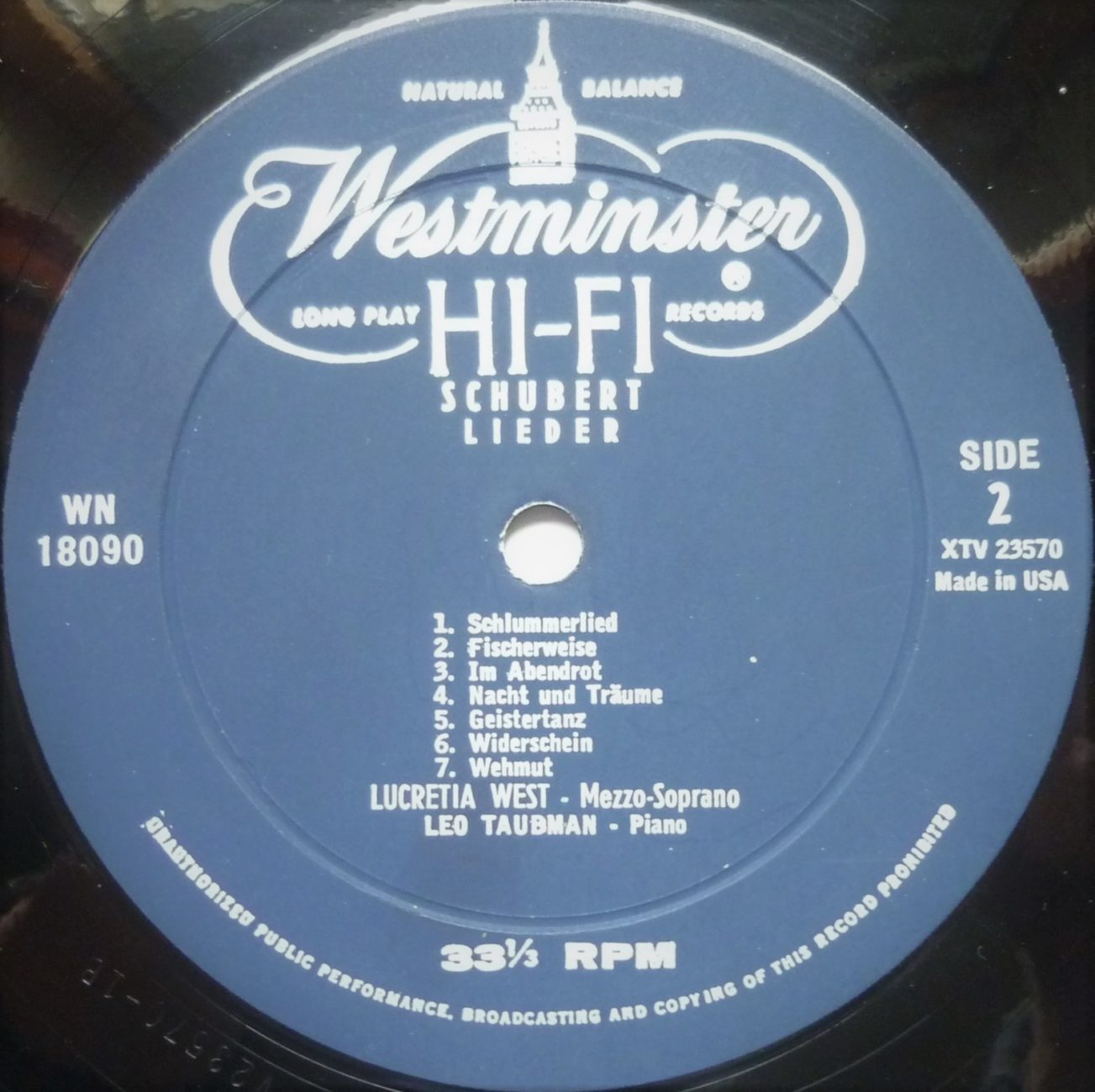
US singer Lucretia West (1922-2022) made most of her career in Switzerland and in Germany. A grant from the ‘John Hay Whitney Fondation’ allowed her to complete her studies in Belgium and in Switzerland. She was for a short period a member of the ‘New York City Opera Company’ before returning to Europe in 1957 for the remainder of her career. She taught in Germany before moving back to the United States in 2008.
Her official discography is merely comprised of her recordings for ‘Wesminster’, mainly with Hermann Scherchen (Mahler, Mozart) and with piano accompaniment, and of the ‘Alt-Rhapsodie’ by Brahms with Knappertsbusch (Decca). There also exists a LP with ‘Spirituals’ for ‘Le Club Français de Disque’. A few Radio recordings made in Europe (Schuricht, Mitropoulos) have surfaced, but it might well be that many others exist, especially with Lieder.
Although nominally a mezzo-soprano, she had a tessitura close to that of a contralto. On 9 June 1958, she sang in Hamburg Mahler’s ‘Das Lied von der Erde’ with the NDR Orchestra conducted by Alfred Wallenstein (the tenor was Richard Holm). The concert was broadcast live. A music critic then praised her performance and wrote about her of a ‘Bratschentimbre’ (viola timbre, like the string instrument).
The program of this LP entirely dedicated to Lieder by Schubert by such a low voice is a rarity in itself. She is here remarkably accompanied by Leo Taubman (1907-1966).
* Schubert wrote several versions of this Lied, corresponding to successive versions of the poem. Here, it is the second version and the first revision thereof. The text begins with the following words: «Tom lehnt harrend auf der Brücke…’

Gerhard Hüsch & Hanns-Udo Müller
Source: 33t/LP World Records (Retrospect Series) SH 295
Enregistrement/ Recording: 1935
London Abbey Road Studio n°3: January 31: N° 1-6, 8-10 & 12
February 2: N° 13-18; February 5: N° 7, 11 & 20
Berlin March 22: N° 19
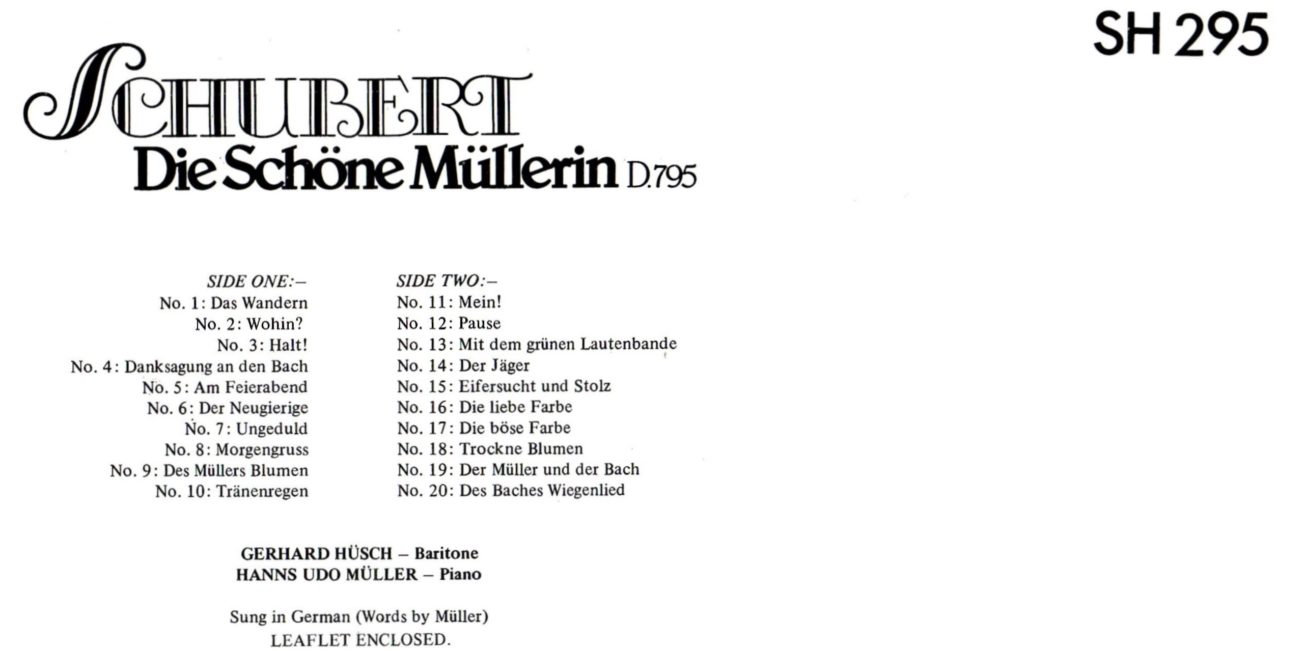
Gerhard Hüsch (1901-1984) formait avec le pianiste Hanns-Udo Müller (1905-1943) un duo d’une rare homogénéité. Leurs enregistrements datent tous d’avant 1941, et Hüsch n’enregistrera quasiment plus par la suite, si bien que tous les témoignages de son art le représentent à son sommet vocal. Cet enregistrement de «Die Schöne Müllerin» de 1935 est d’une telle perfection qu’il constitue depuis sa sortie une référence, reléguant dans l’ombre l’enregistrement intégral fait par Hans Duhan et Ferdinand Foll en 1928. L’interprétation a toute la densité souhaitable, tout en reflétant les suggestions du poète Wilhelm Müller qui ouvrent et referment le cycle (Der Dichter, als Prolog, et Der Dichter als Epilog, que Schubert n’a pas mises en musique): il ne faut pas prendre trop au tragique ce qui n’est qu’une fiction.
L’édition en microsillon par le label World Records d’Anthony Griffith à partir de pressages vinyle des matrices métalliques des 78 tours restitue fidèlement l’interprétation et l’ambiance de salle, si bien que l’on entend notamment la différence de prise de son pour le Lied n°19 «Der Müller und der Bach», ré-enregistré en mars à Berlin.
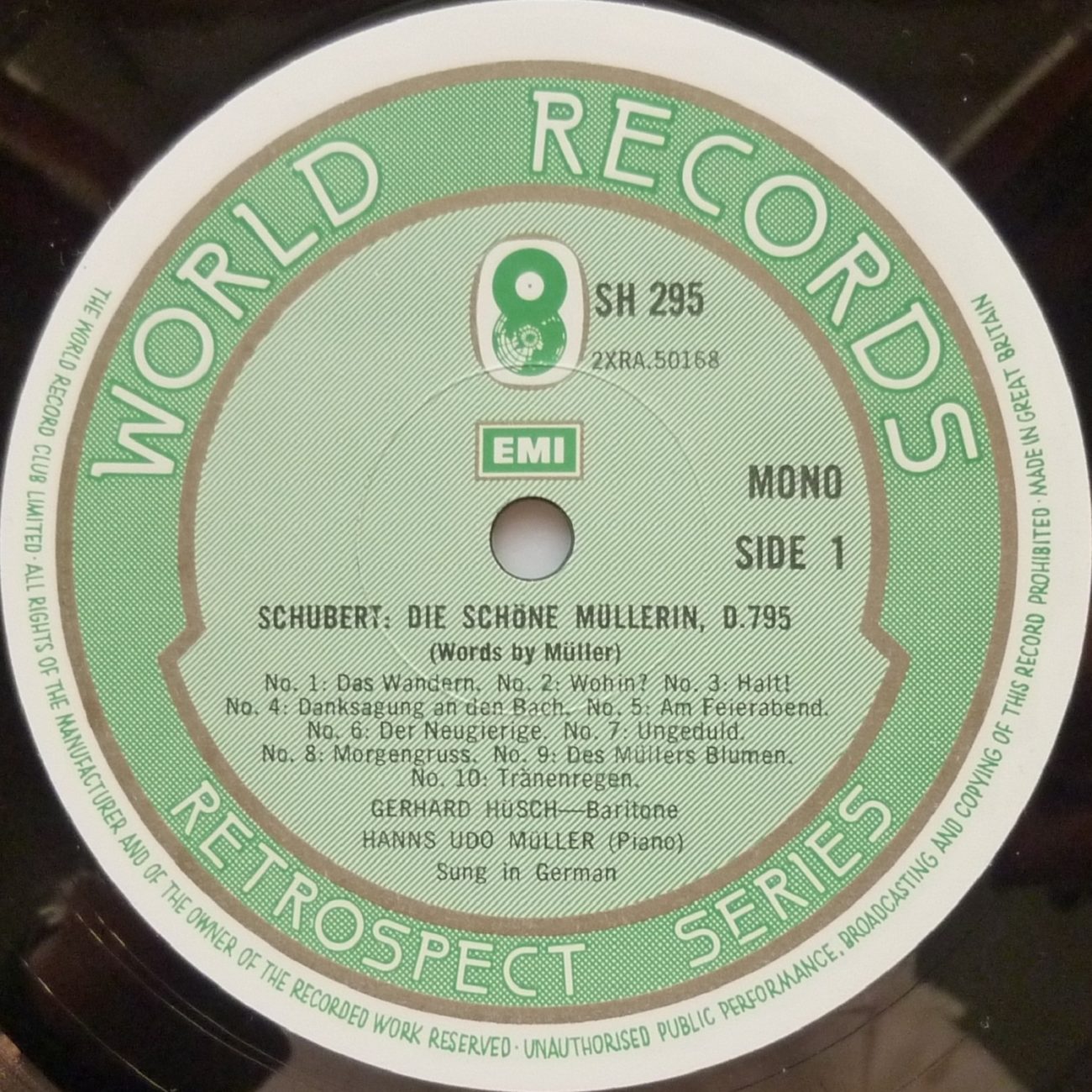

Gerhard Hüsch (1901-1984) together with pianist Hanns-Udo Müller (1905-1943), this was an exceptionally homogeneous duet. Their recordings were all made before 1941, and Hüsch was to record almost nothing afterwards, so that all the testimonies of his art show him at his vocal best. This 1935 recording of «Die Schöne Müllerin» is so perfect that it is a reference since it was issued, which meant also that the complete recording made by Hans Duhan and Ferdinand Foll in 1928 fell into oblivion. The performance has all the required density, while reflecting the suggestions by poet Wilhelm Müller which open and close the cycle (Der Dichter, als Prolog, and Der Dichter, als Epilog, not set to music by Schubert): what is only a story should not be taken too tragically.
The LP issue by Anthony Griffith’s label World Records from vinyl pressings of 78rpm metal masters is true to the performance and to the room ambiance, so that even the difference in sound for Lied n°19 «Der Müller und der Bach», re -recorded in March in Berlin, is clear for the listener.

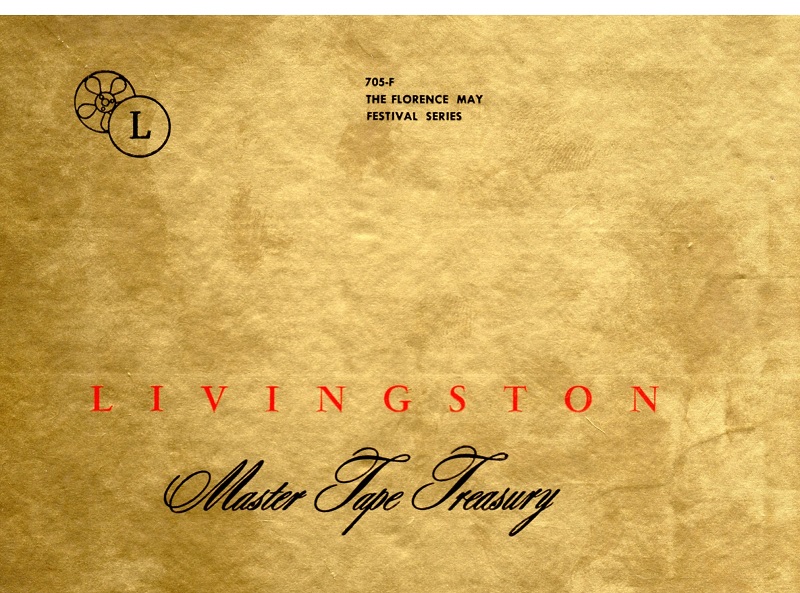
Vittorio Gui – Orchestra del Maggio Musicale Fiorentino
Schubert Symphonie n°8 D759
Rossini Guillaume Tell Ouverture
Brahms Akademische Festouvertüre Op.80
Massenet-Scènes Alsaciennes: n°3 Sous les Tilleuls
Enr/Rec: Teatro Comunale di Firenze – May – June 1953 Stereo
Source: Bande/Tape Audiosphere 701-BN & Livingston 705F
Le Mai Musical Florentin de 1953 (XVI Maggio Musicale Fiorentino) est resté célèbre en raison des représentations de la Medea de Cherubini avec Maria Callas sous la direction de Vittorio Gui.
Fait moins connu, au cours de ce Festival, ont été réalisés les premiers enregistrements stéréophoniques commerciaux en Europe, sous la direction de Vittorio Gui, pour le label américain Livingston fondé par Ched Smiley.
Le directeur artistique de cette production était le chef Hans Wolf (Hamburg 1912- Seattle 2005). Il a étudié notamment avec Heinrich Schenker en 1933 et 1934 et a poursuivi ensuite des études à Vienne. Comme Marcel Prawy dont il était l‘ami, Il s’est engagé dans l’armée américaine en 1943, a obtenu la nationalité américaine et a été envoyé à Vienne au printemps 1945. Avant de s’installer aux Etats-Unis en 1952, il a fait des enregistrements pour le label Remington et un orchestre dénommé «Austrian Symphony Orchestra« (qui était en fait le Niederösterreichisches Tonkünstler Orchester) entre 1950 et février 1952, en tant que chef d’orchestre (Beethoven Symphonie n°5, Brahms Symphonie n°2, Franck Symphonie etc…). Il a également été producteur associé avec Marcel Prawy, pour les enregistrements avec Fritz Busch avec le même orchestre (Haydn Symphonie n°101, Beethoven Symphonies n°3 et 8) pour lesquels l’ingénieur du son était Hans Sachs de la Radio autrichienne RAVAG) et, fait notable avec Vittorio Gui (Mendelssohn: Symphonie n°5 et Ouverture «Les Hébrides», ainsi qu’un disque d’ouvertures).

Hans Wolf – Marcel Prawy – Fritz Busch – Hans Sachs – Wien Oktober 1950
Par ailleurs, le label Livingston était à l’époque engagé dans des recherches de stéréophonie expérimentale, notamment avec le concept de disque à double sillon d’Emery Cook, pour lequel Livingston a commercialisé un bras de lecture « Binaural Arm »:
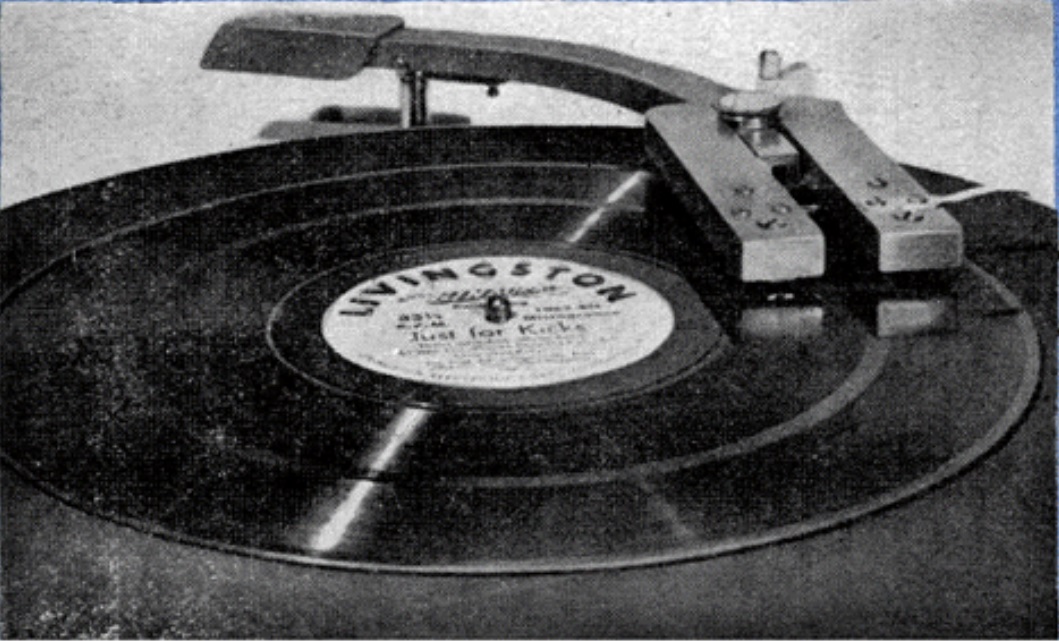
Livingston Binaural Arm
Le nouveau projet de Livingston qui a vu le jour en 1953 était la commercialisation en stéréophonie, sur bandes magnétiques, d’une importante série d’ enregistrements orchestraux faits à Florence sous la direction de Vitorio Gui au cours du Mai Musical Florentin qui a eu lieu entre le 7 mai et le 29 juin 1953. Livingston n’était pas le seul avec un tel projet, mais ses enregistrements orchestraux en stéréo ont précédé ceux d’ AV-Tapes Libraries (Sibelius: Cincinnati SO Thor Johnson enregistré en novembre 1953).
Cinq bandes magnétiques référencées 701 à 705 publiées par Livingston/Audiosphere ont été annoncées dans les numéros de juin et d’août 1954 de la revue Tape Recordings, après avoir fait l’objet au mois de mars d’une présentation au public à Cleveland (Cleveland Chapter 18th Symposium «Stereo Symposium») sous la forme d’émissions radiophoniques FM expérimentales en stéréo.
Lors des séances d’enregistrement à Florence, deux jours ont été consacrés à la mise en place des microphones et à la balance de l’orchestre, le montage des bandes a été réalisé sur place, et les enregistrements ont fait l’objet d’une écoute en vue de leur approbation.
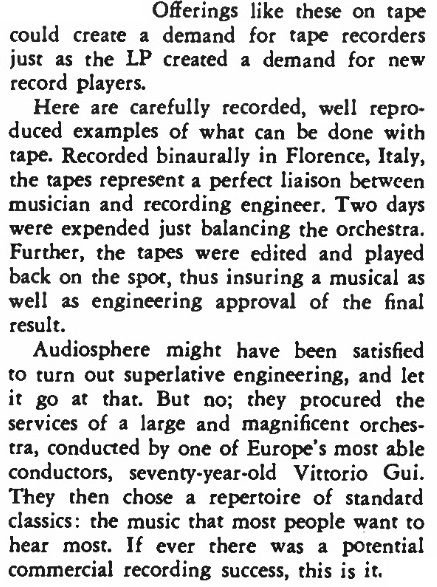
Presentation (Tape Recordings: June 1954)
Dans un article intitulé «Tape makes it easier» paru dans le numéro d’avril 1955 de la Revue «Tape Recordings«, Hans Wolf a dévoilé sa conception personnelle des enregistrements sur bande magnétique et sur le montage, et il a raconté la visite d‘Heinrich Kralik, musicologue et Directeur du département musical de la Radio Autrichienne RAVAG, lors du montage des enregistrements de Vittorio Gui dans une petite salle du Teatro Comunale. Pour le lire, cliquer ICI.
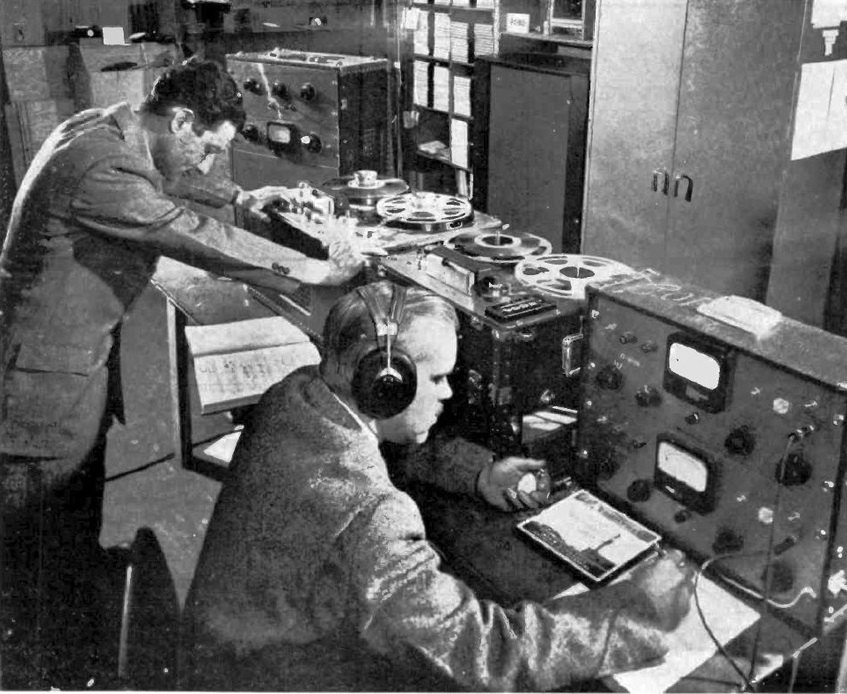
Hans Wolf & Ched Smiley
Les annonces de publications de bandes magnétiques stéréophoniques par de petites firmes (Livingston/Audiosphere et AV Tapes Library) ont créé une forte incitation pour les grands labels et en tout premier lieu RCA qui a annoncé dès juillet 1954 dans la revue High Fidelity sa première publication d’une bande magnétique en stéréo: Strauss Also sprach Zarathustra Chicago SO Fritz Reiner, enregistrement du 6 mars 1954.
Par la suite, les publications pionnières de Livingston sont progressivement tombées dans l’oubli jusqu’à la réédition en 2014 des enregistrements de Vittorio Gui sous le propre label du Festival «Historical Maggio Live» (2CD OF 003).

Bande /Tape Audiosphere BN701

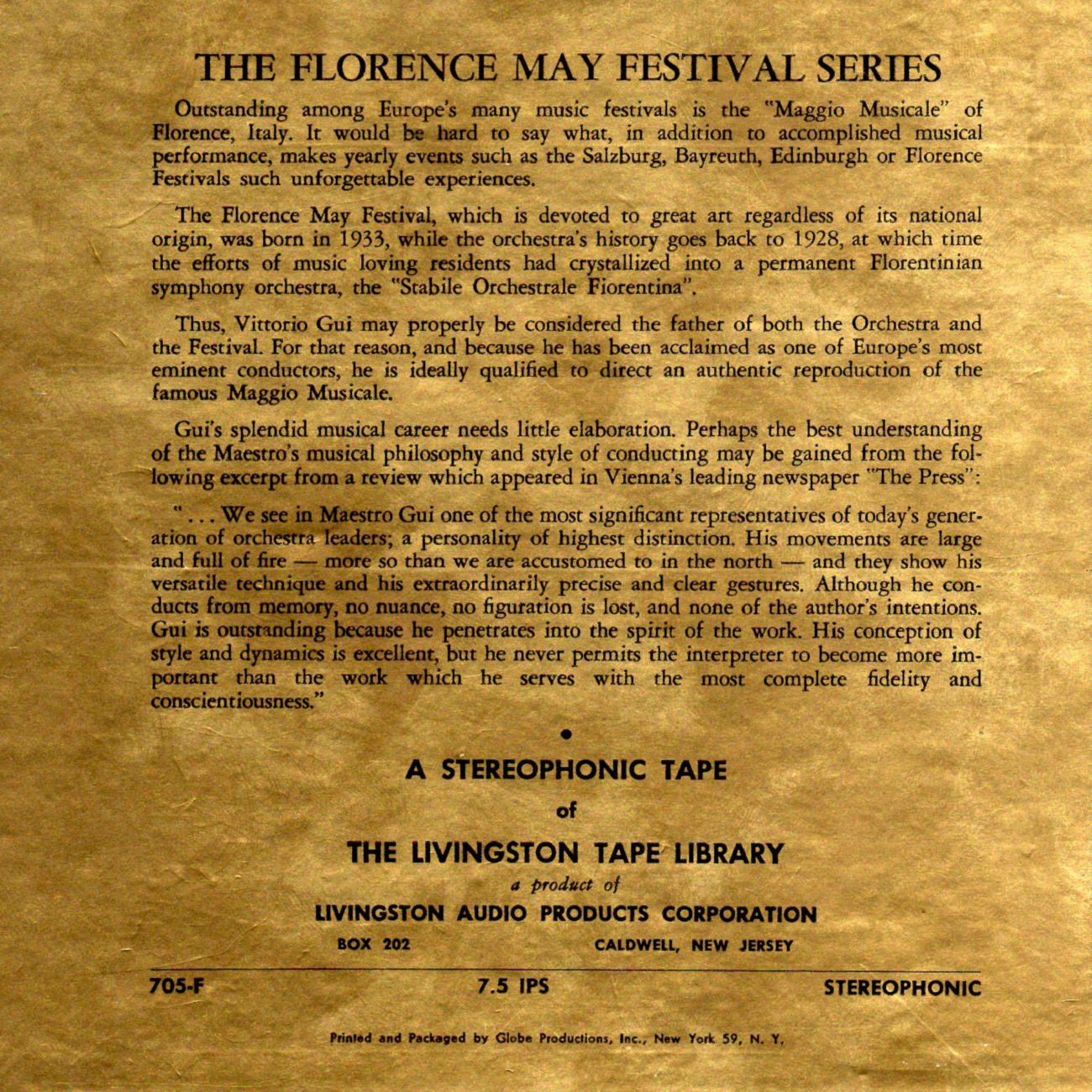
Bande /Tape Livingston 705-F

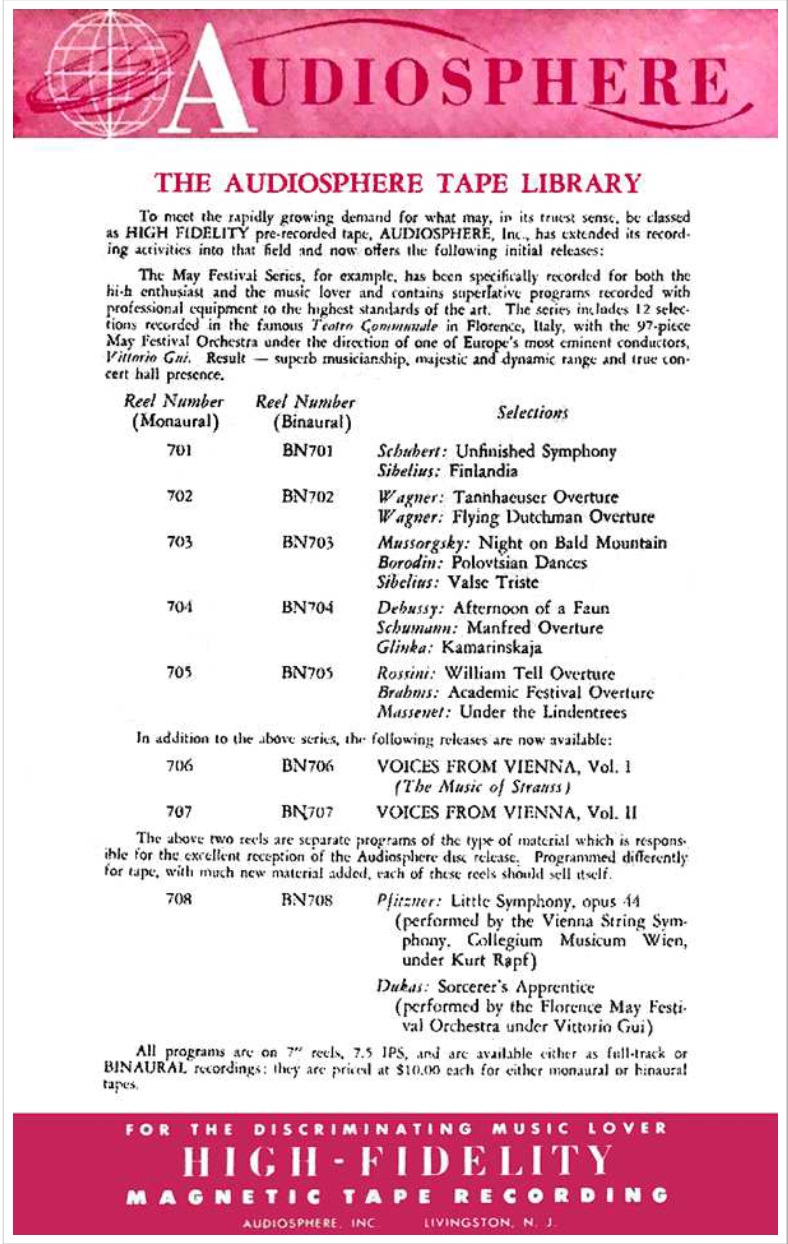
Audiosphere Catalog December 1954
The 1953 Florence May Festival (XVI Maggio Musicale Fiorentino) has remained memorable because of the performances of Cherubini’s Medea with Maria Callas conducted by Vittorio Gui.
But it is much lesser known that during this Festival, the first commercial stereophonic recordings in Europe were made with conductor Vittorio Gui, for the US Livingston label founded by Ched Smiley.
The musical producer was conductor Hans Wolf (Hamburg 1912- Seattle 2005). He studied among others with Heinrich Schenker in 1933 and 1934 and then further studied in Vienna. In the same way as Marcel Prawy who was his friend, he joined the US Army in 1943, became a US citizen and was sent to Vienna in the Spring of 1945. Before settling in the USA in 1952, he made recordings for the Remington label and the so-called «Austrian Symphony Orchestra « (which was in fact the Niederösterreichisches Tonkünstler Orchester) between 1950 and February 1952, as a conductor (Beethoven Symphonie n°5, Brahms Symphonie n°2, Franck Symphonie etc…). He was also the assisting producer to Marcel Prawy, for the recordings with Fritz Busch with the same orchestra (Haydn Symphony n°101, Beethoven Symphonies n°3 and 8) for which the recording engineer was Hans Sachs from the Austrian Radio (RAVAG) and, also worth noting, with Vittorio Gui (Mendelssohn: Symphony n°5 and Overture «Hebriden», as well as a LP comprised of overtures).
On the other hand, the Livingston label was then involved in research in experimental stereophony, especially with Emery Cook’s double groove LP concept, for which Livingston sold a tone arm called « Binaural Arm »:
The new Livingston concept that materialized in 1953 was the commercialization on stereophonic magnetic tapes of an important series of recordings made in Florence under the direction of Vitorio Gui during the May Festival which took place between May 7 and June 29, 1953. Livingston was not the only one with such an idea, but its stereo orchestral recordings were made before those of AV-Tapes Libraries (Sibelius: Cincinnati SO Thor Johnson recorded November 1953).
Five magnetic tapes (Ref: 701 to 705) issued by Livingston/Audiosphere have been announced in the June and August 1954 issues of the review Tape Recordings, just after having been presented to the public in March in Cleveland (Cleveland Chapter 18th Symposium «Stereo Symposium») as experimental stereo FM broadcasts.
Two days of the recording sessions in Florence were used just balancing the orchestra and the tapes were edited and played back on the spot for approval .
In an article titled «Tape makes it easier» published in the April 1955 issue of the review «Tape Recordings«, Hans Wolf unveiled his personal ideas as to recording on magnetic tape and on editing, and he described the unexpected visit of Heinrich Kralik, musicologist and Director of the music department of the Austrian Radio RAVAG, during the editing of Vittorio Gui’s recordings in a small room of the Teatro Comunale. To read it, please click HERE.
The advertised publications of stereophonic magnetic papes by small labels (Livingston/Auduiosphere and AV Tapes Library) generated a strong incentive for the big record companies and in the first place RCA which advertised as early as July 1954 in the review High Fidelity the publication of its first stereo tape: Strauss Also sprach Zarathustra Chicago SO Fritz Reiner, recorded March 6, 1954.
Later on, the Livingston pioneer efforts progressively fell into oblivion until the 2014 re-issue of Vittorio Gui’s recordings by the in-house label «Historical Maggio Live» (2CD OF 003).
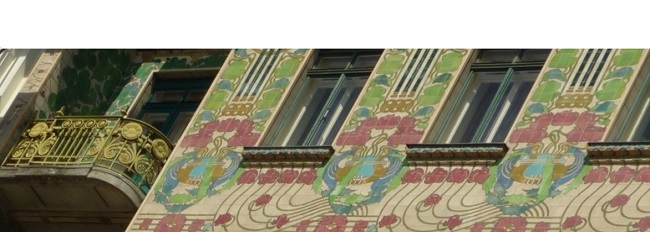
Boskovsky Ensemble – II
Œuvres de Haydn, Schubert, Lanner, Mayer, Stelzmüller et de J. Strauss Sr.
Source: Bande/Tape 19 cm/s / 7.5 ips VTC 1639
Boskovsky Ensemble (membres du WPO, sauf le pupitre de guitare):

Violon I : Willi Boskovsky (1908-1991) « Stimmführer » des violons I de 1934 à 1938, puis Konzertmeister de 1938 à 1970
Violin II : Wilhelm Hübner (1914-1996) « Stimmführer » des violons II de 1954 à 1964, « Vorgeiger » ensuite jusqu’en 1980 (retraite)
Violin III et Alto: Rudolf Streng (1915-1988) violon I de 1938 à 1959; alto solo de 1959 à 1980 (retraite)
Contrebasse: Otto Rühm (1906-1979) contrebasse solo de 1955 à 1971 (retraite)
Flûte: Josef Niedermayr (1900-1962) flûte solo de 1933 à 1962
Clarinette: Rudolf Jettel (1903-1981) clarinette solo de 1945 à 1968 (retraite)
Cors: Otto Nitsch (1906-1982) 2ème cor de 1941 à 1971; Roland Berger(1937) 3ème cor au Wiener Staatsoper (1955); cor solo de 1961 à 1984; de nouveau 3ème cor de 1984 à 1993 (retraite)
Guitare: Alois Pistor (Haydn Zingarese) ; Karl Scheit
01- Johann Strauss Sr. : Gitana Galopp Op.108 pour 2 violons, alto, contrebasse, flûte, clarinette et 2 cors
02- Johann Mayer: Schnofler Tanz’ pour 2 violons et guitare
03- Josef Haydn: Zingarese n°1, 6 & 8 pour 2 violons, guitare, contrebasse, flûte et clarinette
04- Franz Schubert: Danses Op.9 n° 18, 67, 77 & 127 pour 2 violons, alto et contrebasse
05- Johann Strauss Sr. : Annen Polka Op.137 pour 2 violons, alto, contrebasse, flûte, clarinette et 2 cors
06- Josef Lanner: Abendsterner Walzer Op.180 pour 3 violons et contrebasse
07- Johann Strauss Sr. : Hofball Tänze pour 3 violons et contrebasse
08- Vincenz Stelzmüller: Stelzmüller Tanz’ pour 2 violons et guitare
09- Johann Strauss Sr. : Seufzer Galopp Op.9 pour 2 violons, contrebasse, flûte, clarinette et 2 cors
10- Josef Lanner: Neue Wiener Ländler Op.1 pour 3 violons et contrebasse
11- Franz Schubert: Ecossaisen Op.49 pour 2 violons, alto, contrebasse, flûte, clarinette et 2 cors
12- Josef Haydn: Katherinen Tänze n° 4, 12, 6 & 8 pour 2 violons, alto, contrebasse, flûte, clarinette et 2 cors
L’enregistrement a été réalisé en 1961 dans la Festsaal du Casino de Baumgarten.
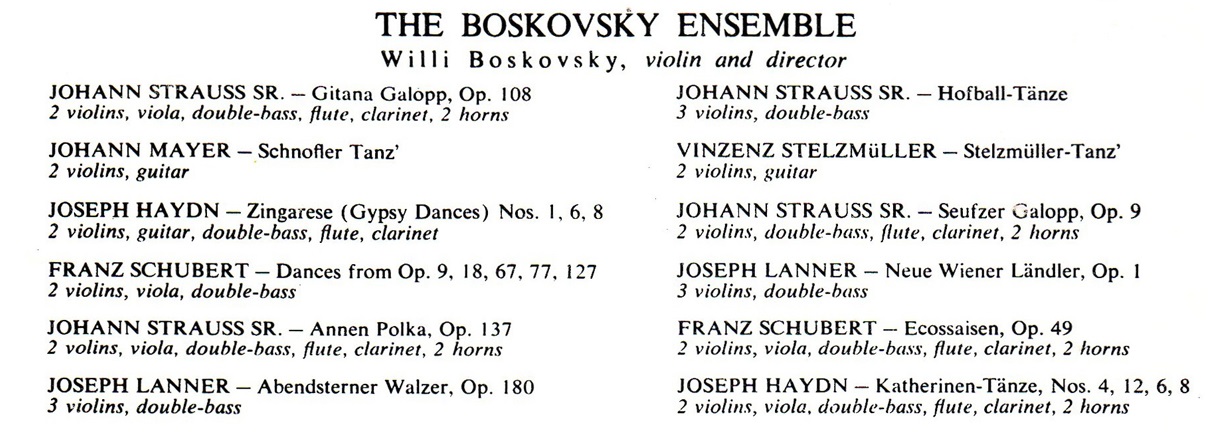
The recording was made in 1961 in the Festsaal of the Baumgarten Casino.
____________
La tradition des petits ensembles de musique populaire viennoise date de bien avant le très officiel concert du Nouvel An donné par les Wiener Philharmoniker (WPO). Avec le Boskovsky Ensemble, les membres du WPO nous prouvent qu’ils maîtrisaient parfaitement ce style.
Comme montre la photo ci-dessous qui date de 1927, cette tradition ne se limitait pas du tout à la musique viennoise. On remarque que, pour ce répertoire inhabituel, il a été fait appel à non pas un, mais deux chefs d’orchestre, choisis parmi les plus prestigieux, Franz Schalk et Richard Strauss!
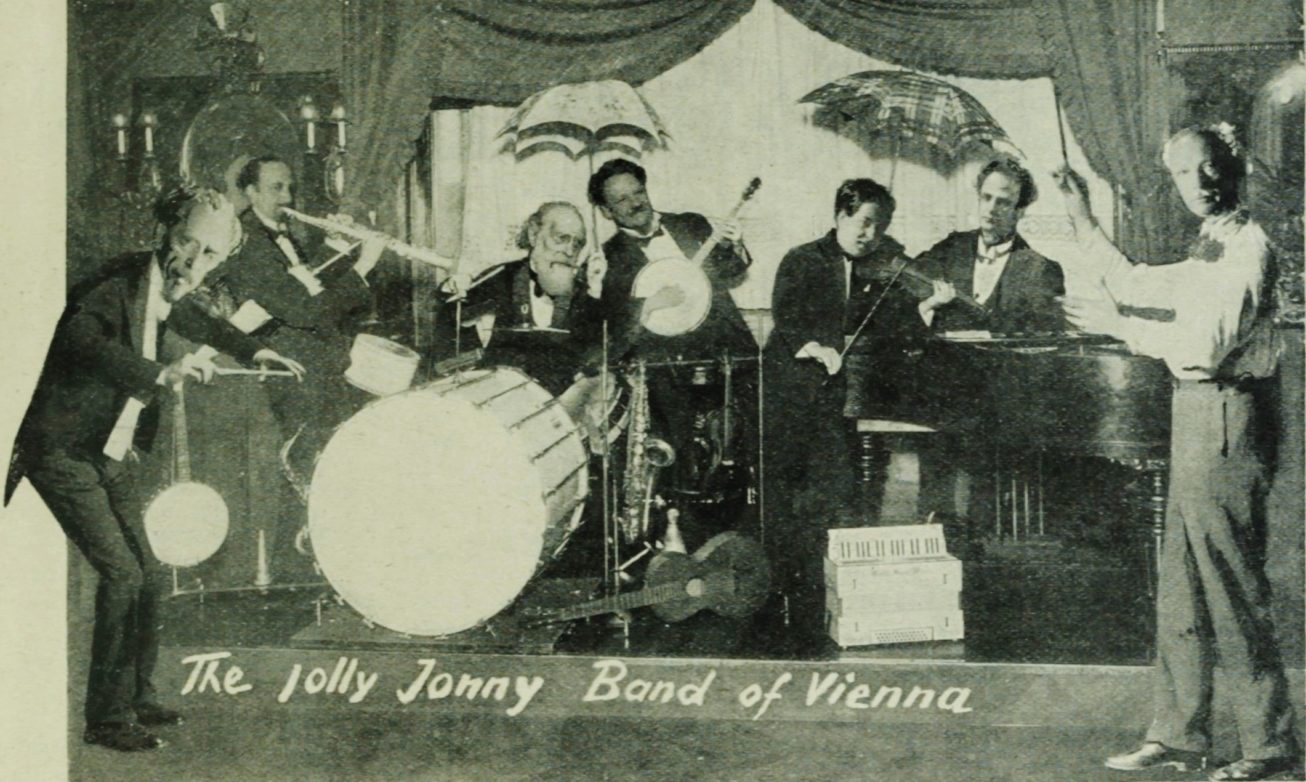
Franz Schalk; Paul Stefan, flûte; Wilhelm Kienzl, percussion; Leo Slezak, banjo; Erich Wolfgang Korngold, violon; Wilhelm Furtwängler, piano; Richard Strauss (1927)
The tradition of small ensembles of Viennese popular music is much older than the very official New Year concert of the Wiener Philharmoniker (WPO). With the Boskovsky Ensemble, the members of the WPO prove that they perfectly mastered this style.
But as the above picture taken in 1927 shows, this tradition was not at all limited to Viennese music. Worth mentioning is that, for this unusual repertoire, there were not only one, but two conductors, chosen among the most prestigious, Franz Schalk and Richard Strauss!
____________
Boskovsky Ensemble (members of the WPO, except the guitar players):
Violin I : Willi Boskovsky (1908-1991) « Stimmführer » of violins I from 1934 to 1938, then Konzertmeister from 1938 to 1970
Violin II : Wilhelm Hübner (1914-1996) « Stimmführer » of violins II from 1954 to 1964, then « Vorgeiger » until 1980 (retirement)
Violin III and Viola: Rudolf Streng (1915-1988) violin I from 1938 to 1959; solo viola from 1959 to 1980 (retirement)
Double-bass: Otto Rühm (1906-1979) solo double-bass from 1955 to 1971 (retirement)
Flute: Josef Niedermayr (1900-1962) in the orchestra since 1921; solo flute from 1933 to 1962
Clarinet: Rudolf Jettel (1903-1981) solo clarinet from 1945 to 1968 (retirement)
Horns: Otto Nitsch (1906-1982) 2nd horn from 1941 to 1971; Roland Berger(1937) 3rd horn at the Wiener Staatsoper (1955); solo horn between 1961 and 1984; then again 3rd horn between 1984 and 1993 (retirement)
Guitar: Alois Pistor (Haydn Zingarese); Karl Scheit

Les liens de téléchargement sont dans le premier commentaire. The download links are in the first comment.



